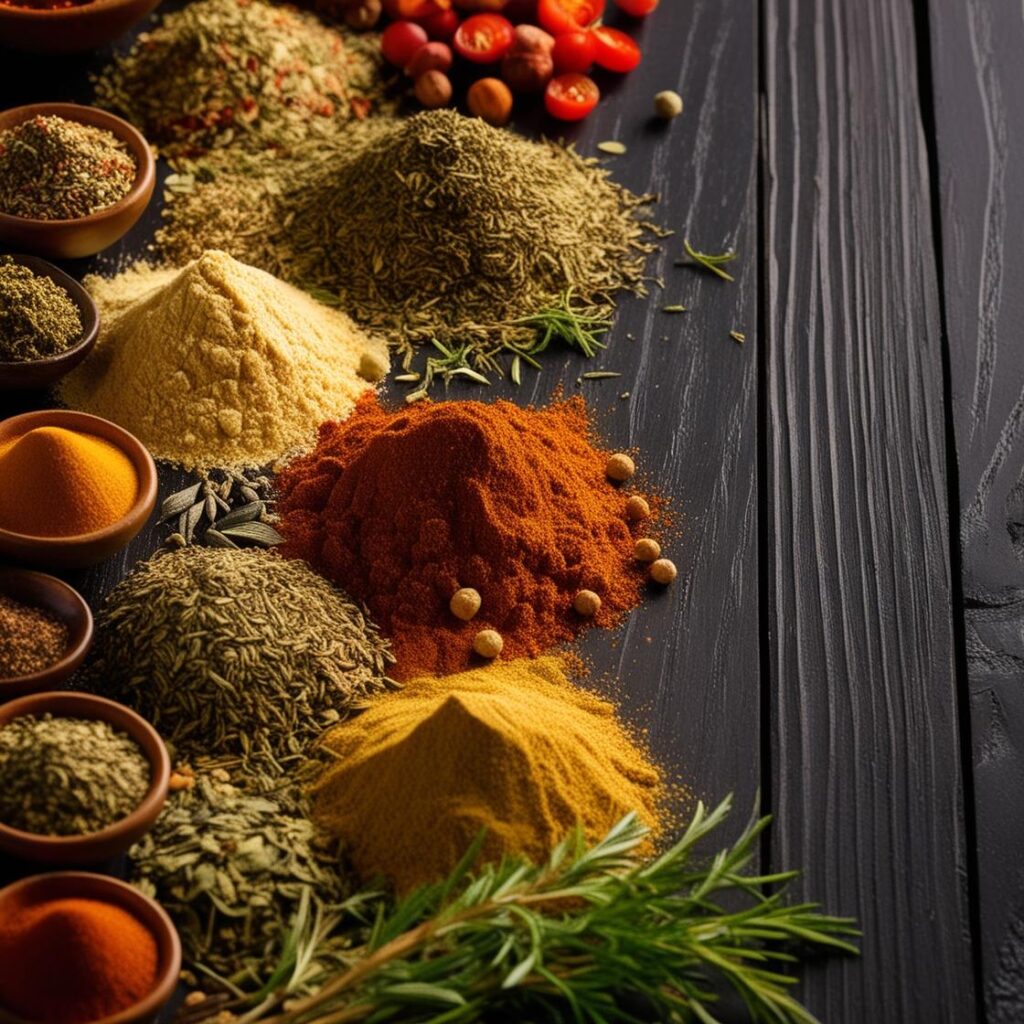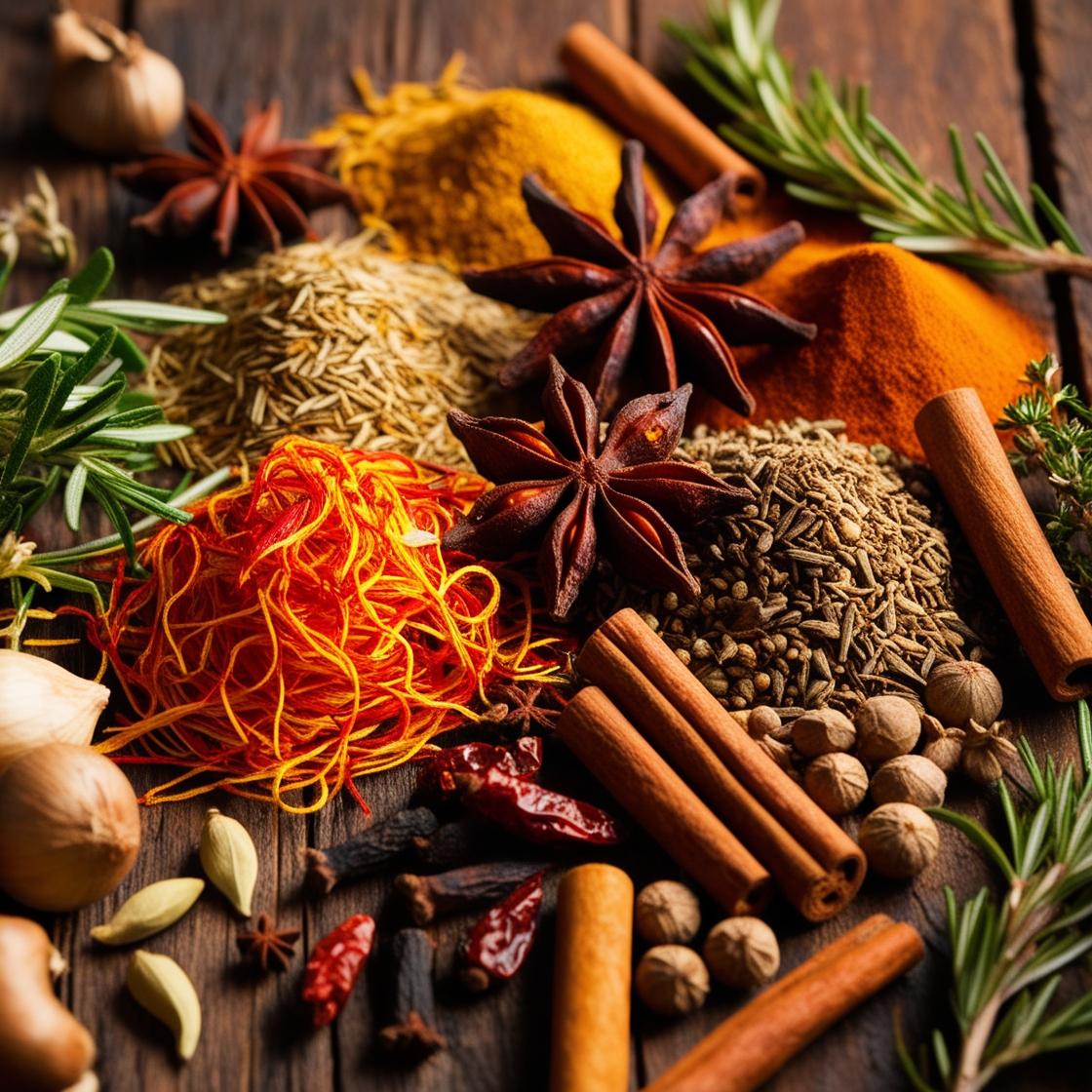Spices and herbs have been at the heart of culinary traditions for centuries. Whether it’s the rich aroma of cinnamon or the zing of ginger, these ingredients have shaped the flavors of cuisines across the world. From the bustling spice markets of India to the subtlety of Southeast Asian kitchens, spices carry stories of history, culture, and flavor. In this article, we’ll take a closer look at some of the most important tropical spices and herbs, exploring their unique characteristics, origins, and uses.
Let’s dive into the fascinating world of spices!
















Black Pepper, Nutmeg, and the Classics
Many spices, such as black pepper and nutmeg, are widely recognized around the world. Their strong flavors have earned them a permanent place in global kitchens, particularly in Europe, where they were once worth their weight in gold. Originating in Southeast Asia, these spices were among the first to be transported across continents. Today, they continue to enhance dishes, whether ground fresh over a dish or simmered in a sauce.
Quick Tip:
- Always grind black pepper fresh for maximum flavor. Pre-ground pepper can lose its potency over time.
Galangal: The Spice You Need to Know
One of the more exotic spices is galangal. Native to Southeast Asia, galangal belongs to the ginger family but boasts its own unique, peppery aroma. Its rhizomes are often used in Thai and Indonesian cuisine, where it adds a vibrant kick to curry pastes, stir-fries, and soups. If you’ve ever enjoyed the flavors of a Thai green curry, you’ve tasted the magic of galangal.
Actionable Tip:
- Freshly grated galangal works best in curries. If you can’t find fresh, the dried version can be substituted but remember to soak it in warm water before use.
Annatto: A Colorful Addition
Known for its bright red hue, annatto, or achiote, is another must-know spice. Used as a natural food coloring, annatto gives an orange-yellow tint to butter, cheeses, and traditional Latin American dishes like empanadas. But it’s not just about color; annatto seeds also provide a mildly spicy, nutty flavor that enhances sauces, rice, and meats.
Fun Fact:
- Indigenous tribes in South America once used annatto as body paint and lipstick! The vibrant color is still a key part of cultural ceremonies in some regions.
Fingerroot: The Unsung Hero
Fingerroot, also called Chinese ginger, is a lesser-known but incredibly flavorful spice. It’s particularly popular in Thai and Malay cuisine, where its fresh rhizomes are grated or sliced to add a zesty note to fish curries, stews, and soups. While it may not be as globally famous as its cousin ginger, it’s an essential ingredient in Southeast Asian cooking.
Pro Tip:
- Try using grated fingerroot in marinades for fish or chicken to bring out a subtle, aromatic spiciness.
Khat: A Cultural Experience
Khat isn’t your typical spice, but it holds significant cultural importance in East Africa and the Middle East. The fresh or dried leaves are chewed for their stimulating effects, often as part of social rituals and traditional ceremonies. While khat has some controversial uses due to its addictive nature, its role in regional culture cannot be denied.
Tea: More Than Just a Drink
The world’s second most consumed beverage, tea (from the Camellia sinensis plant), has been enjoyed for centuries. Whether it’s the fresh, bright notes of green tea or the deep, robust flavors of black tea, this evergreen plant is harvested and processed into different varieties. Tea is cherished worldwide and forms an integral part of many cultures, from India’s chai to China’s traditional tea ceremonies.
Tea Brewing Tip:
- For a perfect cup of green tea, steep leaves in water that’s just under boiling to preserve the delicate flavors.

Cinnamon: Sweet and Spicy Perfection
We can’t talk about spices without mentioning cinnamon. This fragrant bark, particularly the Ceylon cinnamon variety, has been a staple in kitchens for thousands of years. Whether sprinkled over pastries, brewed into tea, or added to savory dishes like curries and stews, cinnamon brings warmth and depth to countless recipes.
Health Note:
- Cinnamon has antibacterial properties and has been used in traditional medicine to treat ailments like diarrhea and bacterial infections. It’s also rich in antioxidants, making it a healthy addition to your diet.
Summary for Instagram Reels or Infographics
- Spices Shape Cultures: From black pepper to cinnamon, spices have played a huge role in history and continue to enhance our meals today.
- Galangal’s Zing: Adds a peppery, citrus-like punch to Southeast Asian curries and stir-fries.
- Annatto for Color and Flavor: Known for its bright hue and mild spiciness, it’s a must for Latin American cooking.
- Fingerroot’s Aromatic Power: A secret weapon in Thai curries and stews with a ginger-like taste.
- Khat’s Cultural Role: Chewed for its stimulating effects in East African and Middle Eastern traditions.
- Cinnamon’s Sweet Legacy: Used in everything from baked goods to savory curries, with added health benefits.
With these spices in your pantry, you’re not just cooking; you’re connecting with centuries of flavor and culture!
Curcuma longa L. (Turmeric)
Family: Zingiberaceae (Ginger family)
Food Uses:
Turmeric is a staple in curries, giving them their yellow color. In Southeast Asia, fresh, grated turmeric is favored over dried powder. Turmeric also colors mustard, beverages, sweets, ice cream, butter, margarine, and cereals.
Comments:
Containing 5% essential oils and 5% curcumin (the main contributor to its color and flavor), turmeric has long been used in traditional medicine, treating digestive disorders, wounds, and infections. Modern research is exploring its potential in cancer and Alzheimer’s treatment. In India, turmeric is mixed with lime juice to make kumkum, a paste used in Hindu rituals.
Description:
A perennial herb reaching 60-90 cm (24-36 in) in height with elliptical leaves, yellowish-white flowers, and bright orange rhizomes. The rhizomes, 6-12 cm (2.4-5 in) long, have a spicy, peppery flavor.
Origin and Distribution:
Its exact origin is difficult to trace, but turmeric has been used in India for over 4,000 years. It thrives in humid, tropical climates with well-drained soils, from sea level up to 1,500 m (5,000 ft).
Cymbopogon citratus (Lemongrass)
Family: Poaceae (Grass family)
Description:
A perennial herb growing 0.6–1 m (2–3.3 ft) tall with drooping blue-green leaves and inconspicuous flowers in panicles. The leaves, which contain citral and limonene, have a strong lemon-like aroma.
Origin and Distribution:
Lemongrass likely originated in tropical Asia, though its exact origin is unknown due to its widespread cultivation.
Food Uses:
Fresh and dried lemongrass leaves are common in Southeast Asian cooking, especially in soups, stews, and curry pastes. They are also used to make tea.
/
Elettaria cardamomum (Cardamom)
Family: Zingiberaceae (Ginger family)
Description:
A tall, herbaceous perennial reaching 3-4 m (10-13 ft) with lanceolate leaves. Its flowers produce green capsules containing aromatic black seeds.
Origin and Distribution:
Native to India, Sri Lanka, Malaysia, and Indonesia, cardamom grows in the understory of tropical rainforests.
Food Uses:
Cardamom seeds are widely used in Middle Eastern, South Asian, and European dishes. They flavor curries, bread, and sweets and are used to make aromatic coffee and tea.
Comments:
Cardamom has been used in traditional Indian medicine for digestive issues, asthma, and lack of appetite.
Eryngium foetidum (Culantro)
Family: Apiaceae (Carrot family)
Description:
A perennial herb with a rosette of serrated, aromatic leaves and small, white to purple flowers in umbels.
Origin and Distribution:
Native to tropical America, it is widely cultivated in Vietnam, Thailand, and India.
Food Uses:
Culantro leaves are used in soups, chutneys, and sauces, imparting a stronger flavor than cilantro. It is a key ingredient in salsa and ceviche.
Comments:
Rich in essential oils and vitamins, culantro has medicinal uses for stimulating appetite, treating fevers, and respiratory infections.
Lippia graveolens (Mexican Oregano)
Family: Verbenaceae (Vervain family)
Description:
An evergreen shrub reaching 1.5–2.5 m (5–8 ft), with aromatic, grayish-green leaves and small flowers in clusters.
Origin and Distribution:
Native from the southwestern U.S. to Costa Rica, it thrives in arid and humid tropical climates.
Food Uses:
Its leaves, stronger than Eurasian oregano, are used to flavor soups, stews, and tomato-based dishes. It’s a key ingredient in Mexican cuisine, including chile con carne.
Comments:
Herbal teas from Mexican oregano are used traditionally to treat respiratory infections.




































Moringa oleifera (Horseradish Tree)
Family: Moringaceae
Description:
A medium-sized tree growing 8–12 m (26–39 ft) with compound leaves and white, fragrant flowers. It produces long seedpods containing winged seeds.
Origin and Distribution:
Native to the Himalayan foothills, it grows in semi-arid tropical and subtropical regions.
Food Uses:
Moringa’s immature pods and leaves are used in curries and stews, while the spicy roots are used in sauces. The seeds can be eaten roasted or cooked, and the seed oil is used for cooking.
Comments:
Moringa seeds are used in cosmetics and skincare.
Murraya koenigii (Curry Tree)
Family: Rutaceae (Citrus family)
Description:
A small evergreen tree, 4-6 m (13-20 ft) tall, with aromatic pinnate leaves and white flowers. Its berries contain poisonous seeds.
Origin and Distribution:
Native to India and Sri Lanka, it’s widely cultivated in tropical Asia.
Food Uses:
Curry tree leaves are used in Indian and Sri Lankan cooking, especially in curries, where they add a distinctive flavor.
Comments:
Curry leaves are best used fresh as they quickly lose their flavor when dried.
Myristica fragrans (Nutmeg)
Family: Myristicaceae (Nutmeg family)
Description:
An evergreen tree producing spherical fruits that split open to reveal a single seed (nutmeg) encased in a red aril (mace).
Origin and Distribution:
Native to the Banda Islands in Indonesia, nutmeg is cultivated in tropical regions worldwide.
Food Uses:
Nutmeg and mace are widely used in baking, meat dishes, sauces, and liqueurs.
Comments:
Nutmeg contains myristicin, which can cause hallucinogenic effects and toxicity in high doses.
Ocotea quixos (Ecuadorian Cinnamon/Ishpingo)
Family: Lauraceae (Laurel family)
Description:
A medium-sized tree with aromatic leaves and cinnamon-like flavor from compounds like methyl cinnamate and trans-cinnamaldehyde.
Origin and Distribution:
Native to Ecuador, it’s used traditionally in religious ceremonies and cooking.
Food Uses:
The bark and leaves flavor desserts and drinks, including Ecuadorian mazamorra morada.
It seems you’re sharing descriptions of various plants and their uses. These include trees, shrubs, and vines used as spices, culinary herbs, and for medicinal purposes. The descriptions detail the plants’ physical characteristics, origins, and how they’re traditionally used. Here’s a brief overview:
- Unnamed Slow-Growing Evergreen Tree:
- Medium-sized tree (8–13 m).
- Lanceolate leaves, new ones are salmon-colored.
- Fruits are dark green to black berries.
- Native to the Amazon lowlands of Colombia, Ecuador, and nearby areas.
- Leaves, cupules, and bark used as spices, with a cinnamon-like aroma.
- Pandanus amaryllifolius (Pandan):
- Shrubby plant (0.5–1 m) with fan-shaped leaves.
- Native to Southeast Asia, used in rice and desserts for its nutty aroma.
- Common in Southeast Asian and Indian cuisines.
- Paullinia cupana (Guaraná):
- Vine (8–12 m), native to the Amazon.
- Used in energy drinks for its caffeine content.
- Seeds traditionally used by Amazonian indigenous peoples for their stimulating effects.
- Pimenta dioica (Allspice):
- Evergreen tree (8–14 m), native to the Caribbean and Central America.
- Fruits have a mix of cinnamon, cloves, nutmeg, and pepper aromas.
- Used in Caribbean cuisine and mole sauces.
- Piper betle (Betel Pepper):
- Climbing plant (up to 20 m).
- Leaves used for chewing with betel nut and as traditional medicine in South Asia.
- Important in cultural rituals and ceremonies.
- Piper nigrum (Black Pepper):
- Perennial vine, native to India.
- Produces the common black, white, green, and red peppercorns.
- A highly prized spice since ancient times, used globally.
- Piper sarmentosum (Vietnamese Pepper):
- Shrublet (0.5–0.9 m), native to tropical Asia.
- Leaves are aromatic and slightly bitter, used in salads and wraps.
- Common in Southeast Asian cuisine.
- Plectranthus amboinicus (Indian Borage):
- Perennial herb (30–60 cm).
- Aromatic leaves used in cooking, particularly for poultry and beef.
- Also used in folk medicine for treating colds and stomach issues.
Would you like a detailed explanation on a specific plant or further details on their uses?
Saccharum officinarum L. – Sugarcane (Poaceae)
Uses and Products:
- Sugarcane is mainly used to produce sugar, which is extracted from the stalks. In tropical regions, sugarcane stalks are chewed or the juice is extracted and sold as a refreshing drink. In Latin America, sugarcane juice is made into solid blocks called tapa de dulce or rapadura. In Asia, the molasses is formed into jaggery.
- Molasses is also fermented to make rum and other sugarcane-based liquors like Brazil’s cachaça.
- The young inflorescences of sugarcane can be eaten raw, steamed, or toasted.
- Ethanol from sugarcane is used as biofuel, especially in Brazil.
Distribution:
- Native to New Guinea, sugarcane spread to Southeast Asia, South Asia, and India, where it was first processed into sugar.
- Today, sugarcane is a major global crop, especially in Brazil, India, China, and Thailand.
Description:
- Sugarcane is a tall grass, growing 4-6 meters in height. The stalks are solid and juicy, with leaves up to 2 meters long. The flowers are produced in silvery white panicles.
Schinus molle L. – Peruvian Pepper Tree (Anacardiaceae)
Uses and Products:
- The seeds of the Peruvian pepper tree are used as a spice, similar to black pepper.
- The red flesh of the fruit is used to make chicha, an alcoholic beverage in the Andean region, and a sweet drink called upi.
- The fruits are also made into miel de molle (syrup) or vinegar.
Distribution:
- Native to dry regions of South America, especially the Andes, from Colombia to Argentina and Chile.
Description:
- The tree grows to 10–15 meters with weeping branches and compound leaves that give off a spicy smell when crushed. It produces small reddish-pink drupes.
Medicinal Uses:
- It is used in traditional medicine for its antibacterial and antiseptic properties.

Syzygium aromaticum (L.) Merr. & L.M. Perry – Cloves (Myrtaceae)
Uses and Products:
- Cloves are used as a spice in a wide range of foods and beverages, including baked goods, sweets, marinades, and spiced teas. They are also used in Indonesian kretek cigarettes.
- Clove oil is used in perfumes, cosmetics, and as a remedy for toothache due to its high eugenol content.
Distribution:
- Native to the Molucca Islands in Indonesia, cloves are now grown in several tropical regions, with Indonesia, Madagascar, and Tanzania being major producers.
Description:
- A 10–20 meter evergreen tree with aromatic leaves and red, unopened flower buds, which are harvested as the spice.
Syzygium polyanthum – Indonesian Bay Leaf (Myrtaceae)
Uses and Products:
- The leaves are used as a spice, particularly in Southeast Asian cuisine. They add flavor to meat, rice, fish, and vegetable dishes, especially in Balinese cuisine.
Distribution:
- Native to Southeast Asia, the tree is found in Myanmar, Thailand, Cambodia, Vietnam, and Indonesia.
Description:
A medium-sized tree with fragrant, lance-shaped leaves. The flowers are small and yellowish-white.
Tubers are underground storage organs of plants that are rich in carbohydrates, primarily starch. They serve as staple foods for many cultures around the world, each region often favoring its own specific species. Here are some notable tubers:
- Potatoes, Taro, Cassava, Yams: These are some of the most consumed tubers globally, providing essential nutrition for millions of people. They are used as daily food staples, especially in tropical regions.
- Geographic Preferences:
- Europe & North America: Potatoes and sweet potatoes are most common.
- South America: Cassava and potatoes are popular.
- Africa: Yam and cassava are staples.
- Asia: Taro is widely consumed.
- Food and Other Uses:
- Many tubers are fermented to produce alcohol.
- Maca, a tuber from South America, is also consumed as an aphrodisiac.
Key Tubers:
- Alocasia macrorrhizos (Giant Taro, Giant Elephant Ear):
Native to Southeast Asia, this large perennial plant produces edible corms. Its stems and young leaves are also consumed after boiling, though raw leaves are toxic due to calcium oxalate crystals and cyanide. - Arracacia xanthorrhiza (Arracacha):
This South American tuber, known for its starchy, carrot-sized roots, is a nutritious food source rich in calcium and vitamins. Its roots are boiled, fried, or roasted, and have a taste described as a blend of roasted chestnuts, parsley, and cabbage. - Colocasia esculenta (Taro):
Another ancient food plant native to Southeast Asia, taro has been cultivated for over 7,000 years. The starchy corms are used much like potatoes, and its leaves are eaten as a vegetable rich in vitamins and minerals. Taro is a staple in Hawaii and other Pacific islands, where it is used to make “poi,” a fermented dish.
Tubers like taro and arracacha have played a significant role in traditional diets and continue to provide essential nutrients in many parts of the world.
Dioscorea alata L. (Winged Yam, Purple Yam)
- Family: Dioscoreaceae
- Description: Vigorous perennial vine, up to 50 ft in length, with winged stems and large cordate leaves. Tubers can weigh up to 22 lbs, with white, cream-colored, or purplish flesh.
- Origin: Likely Southeast Asia, now cultivated in many tropical regions.
- Uses: Tubers are prepared like potatoes (boiled, fried, mashed) and used in desserts like ice cream and pastries. In Africa, they are mashed and served with traditional dishes.
- Nutritional Value: Rich in vitamins C and B6, manganese, potassium, and fiber.
- Comments: Can be a pest in some regions. Tubers can be stored for long periods, important in historic seafaring.
Ipomoea batatas (L.) Lam. (Sweet Potato)
- Family: Convolvulaceae
- Description: Perennial vine with tuberous storage roots, often orange, purple, or red.
- Origin: Native to tropical Central and South America, sweet potatoes have been found in Peruvian caves dated to over 8,000 years ago.
- Uses: Eaten boiled, baked, fried, or candied. Also processed into flour, noodles, and alcohol. Leaves and shoots are eaten as vegetables.
- Nutritional Value: Rich in carbohydrates, beta carotene, vitamins C and B6. Leaves are high in protein.
- Comments: Often confused with yam (Dioscorea spp.), but they are unrelated.
Lepidium meyenii (Maca)
- Family: Brassicaceae
- Description: Low-growing plant native to the high Andes of Peru. Tubers are small, turnip-like, and can be red, purple, or gray.
- Origin: Grows naturally in cold, dry regions of the Andes. Cultivated for at least 4,000 years.
- Uses: Tubers are eaten roasted, boiled, or mashed into a porridge. Also made into flour or fermented into a drink.
- Nutritional Value: High in carbohydrates, protein, essential minerals, and amino acids.
- Comments: Believed to enhance strength and male libido. Maca is gaining popularity globally due to its nutritional properties.

Manihot esculenta (Cassava, Manioc)
- Family: Euphorbiaceae
- Description: Perennial woody shrub producing large, starchy storage roots.
- Origin: Likely native to northern Brazil and southern Mexico.
- Uses: Roots are boiled, fried, roasted, and processed into flour. Also used to make stews and sauces, especially in Africa and Brazil.
- Nutritional Value: High in starch, calcium, vitamin C, and phosphorus.
- Comments: Cassava contains toxic glucosides and must be soaked and boiled to remove them. Used for both food and biofuel production.
Mirabilis expansa (Mauka, Chaga)
- Family: Nyctaginaceae
- Description: Herbaceous plant native to the Andes, producing starchy, conical tubers.
- Origin: High-altitude regions of the Andes in South America.
- Uses: Tubers are boiled, fried, or eaten sweetened. Leaves and shoots are also consumed.
- Nutritional Value: High in carbohydrates, calcium, potassium, and phosphorus.
- Comments: An ancient crop, now rare, but highly nutritious. Treated tubers become sweeter with exposure to cold.
Oxalis tuberosa (Oca)
Comments: After the potato, it is the second most important tuber of the high Andes. Known for its pleasant, nutty flavor.
Family: Oxalidaceae
Description: Perennial plant with tubers that come in a variety of colors, ranging from dark purple to pink and yellow.
Origin: Native to the Central Andes, cultivated in high-altitude regions.
Uses: Tubers are boiled, fried, or roasted. In the Andes, they are preserved using a freeze-drying method.
Nutritional Value: High in carbohydrates and contains about 9% protein.
The section you shared provides detailed descriptions and uses of various tubers from around the world. Here’s a summary of the key tubers mentioned:
- Yam Bean (Pachyrhizus erosus)
- Family: Fabaceae (Bean family)
- Uses: Eaten raw in salads, cooked in savory dishes, and popular in drinks in Mexico. In Southeast Asia, it is used in stir-fries, curries, and soups.
- Origin: Native to Mexico and Central America, spread through Asia and Africa.
- Comments: The green plant parts are poisonous. The tubers have high protein content, and other varieties are cultivated for this purpose.
- Yacon (Smallanthus sonchifolius)
- Family: Asteraceae (Sunflower family)
- Uses: The sweet tubers are eaten raw, boiled, fried, or processed into syrup and juice. They are freeze-dried for preservation in the Andes.
- Origin: Native to the Andes of South America.
- Comments: Yacon is rich in inulin, making it suitable for diabetics and as a low-calorie sweetener. The leaves are used as a protein-rich vegetable.
- Potato (Solanum tuberosum)
- Family: Solanaceae (Nightshade family)
- Uses: Potatoes are versatile, eaten boiled, fried, roasted, and made into liquor like vodka.
- Origin: Native to the Andes, where they have been cultivated for over 8,000 years.
- Comments: Potatoes come in thousands of varieties and are a major global food crop.
- Mashua (Tropaeolum tuberosum)
- Family: Tropaeolaceae (Nasturtium family)
- Uses: Tubers are exposed to cold and sun to reduce pungency and enhance sweetness. They are boiled, used in sweets, or eaten raw.
- Origin: Endemic to the Andes, widely grown in the region.
- Comments: Mashua has high nutritional value and is used in Andean medicine. It is also known for its anti-aphrodisiac properties.
- Ulluco (Ullucus tuberosus)
- Family: Basellaceae (Madeira-vine family)
- Uses: Used in soups, stews, and pickled sauces. The tubers are sometimes freeze-dried for long-term preservation.
- Origin: Native to the Andes and cultivated at high altitudes.
- Comments: Ulluco is the second most important tuber in the Andes after the potato.
- Tannia (Xanthosoma sagittifolium)
- Family: Araceae (Arum family)
- Uses: The corms are boiled, steamed, or fried, and used in dishes like fufu, rondon, and poi. The young leaves are eaten like spinach.
- Origin: Native to Central and South America, grown in tropical regions.
- Comments: Known by various names, such as malanga and cocoyam, it contains easily digestible carbohydrates but is low in protein.
These tubers highlight the diversity of root vegetables used in different cultures for their nutritional value and culinary versatility.
About Us
Welcome to Agriculture Novel, your go-to source for in-depth information and insights into the world of agriculture, hydroponics, and sustainable farming. Our mission is to educate, inspire, and empower a new generation of farmers, hobbyists, and eco-conscious enthusiasts. Whether you’re interested in traditional farming practices or modern innovations, we aim to provide comprehensive guides, expert tips, and the latest updates in agriculture and urban farming.
At Agriculture Novel, we believe in the power of knowledge to transform the way we grow, sustain, and nourish our world. Explore our articles on topics like Fruit Growing Guide, Hydroponics, Plant Deficiency Guide, and more.
Thank you for joining us on this journey towards a greener, more sustainable future!
About Agronique Horizon
At Agronique Horizon, we specialize in delivering comprehensive digital marketing and web development solutions tailored for the agriculture and hydroponics industries. From custom website design and app development to social media management, we provide end-to-end support for brands aiming to make a meaningful impact. Our team also offers innovative solutions for the real estate sector, bringing precision and visibility to your projects. Learn more about our services here and discover how we can elevate your digital presence




